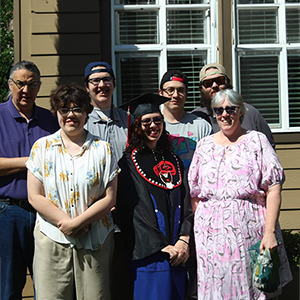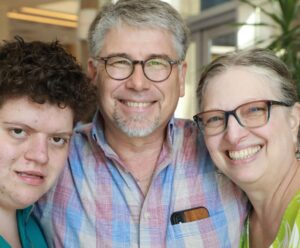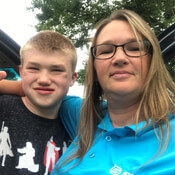FREQUENTLY ASKED QUESTIONS
SMS is a recognizable pattern of physical, behavioral, and developmental features which occur together in the same person due to a small deletion of chromosome 17. Common features include: characteristic, yet subtle, facial appearance, infant feeding problems, low muscle tone, developmental delay, sleep disturbance, self-injurious behaviors, prolonged tantrums, explosive outbursts, speech/language delay, ear infections, arm hugging/hand squeezing and decreased sensitivity to pain.
Although SMS is caused by a deletion of genetic material, it usually does not run in families. In most cases, the deletion occurs accidentally in a child around the time he or she is conceived, without being inherited from either parent. For this reason, we can say that SMS is clearly genetic, but not usually familial. The risk to siblings depends on the results of parental chromosome analysis. If parental chromosomes are normal, the risks to subsequent pregnancies are extremely low. Families are advised to consult a genetics counselor or specialist for further advice regarding their own particular family situation.
Although the exact incidence is not known, it is estimated that SMS occurs in between 1 out of every 15,000 and 25,000 births. SMS is vastly under-diagnosed, but as the awareness of it increases, the number of people identified grows every year.
Although the exact incidence is not known, it is estimated that SMS occurs in 1 out of 15,000 to 25,000 births. SMS is vastly under-diagnosed, but as the awareness of it increases, the number of people identified grows every year.
The diagnosis of SMS is usually confirmed through a clinical blood test called a chromosome analysis. Diagnosis can be made by specific tests to analyze the chromosomes, including a cytogenetic test (karyotype) and FISH (fluorescence in situ hybridization) or by chromosome microarray analysis (also called CGH). Most people with SMS are born with a small deletion (missing section) of one member of their 17th pair of chromosomes. It is the lack of this specific section, known as 17p11.2, which causes a child to develop the features of SMS.
All deletion cases include deletion of the RAI1 gene. In cases where a deletion is not detected, then sequencing of the RAI1 gene should be considered. About 90% of the cases of SMS are due to deletion, with the remaining 10% due to a mutation that occurs within the RAI1 gene.
Sequencing of RAI1 can be done by different types of genetic tests. Tests that include RAI1 sequencing:
- Whole Exome Sequencing
- Panel Genetic Testing
- RAI1 Sequencing
SMS individuals experience hyperactivity, self-injury (including: head banging; hand biting; picking at skin, sores and nails; pulling off finger- and toenails; inserting foreign objects into ears, nose, or other body orifices), explosive outbursts, prolonged tantrums, destructive and aggressive behavior, excitability and arm hugging/hand squeezing when excited.
Unfortunately the published data about the optimal intervention and behavioral strategies in SMS is limited to anecdotal and experiential findings. Many parents report that the use of psychotropic medications benefit SMS individuals with respect to stabilizing mood swings, decreasing anxiety, increasing attention and/or decreasing hyperactivity. However, no single regimen shows consistent efficacy among the majority of persons with SMS.
There is a lot of confusion among parents and school professionals about the meaning of the SMS diagnosis in relation to other types of diagnoses that a child may receive. Like other psychiatric conditions, ADD, ADHD, and PDD are essentially symptom diagnoses, that is, they describe and categorize specific patterns of atypical behavior and development. By contrast, SMS is a cause diagnosis. It is based on specific genetic laboratory findings in a person with developmental and/or behavioral symptoms. By itself, the diagnosis of SMS does not tell you which behavioral symptoms an affected child has – there is a lot of variability from one child with SMS to the next. Among the most common behavioral symptoms associated with SMS are attentional disorders (ADD, ADHD) and autism spectrum disorders (PDD). A child or adult with SMS may have multiple symptom diagnoses plus a cause diagnosis all at the same time.
Efforts to understand sleep patterns and habits in SMS individuals have led to the confirmation of an unusual inverted circadian rhythm of melatonin. Research to determine the underlying cause for this disrupted sleep cycle has only just begun. Therapeutic management of the sleep disorder in SMS remains a challenge for physicians and parents. Reports of therapeutic benefit from melatonin suggest general improvement of sleep without major adverse reactions. However, melatonin dispensed over-the-counter is not regulated in the U.S. by the FDA; thus, dosages prepared by different companies may not be comparable. No formal melatonin treatment trials have been conducted. A parent monitored trial of four to six weeks on low-dose (3 mg) melatonin may be worth considering; continue with melatonin only if your notes indicate an improvement of sleep and/or behavior. It is important to note that high doses (>5 mg) of exogenous oral melatonin may remain in the body into the next morning, and may exacerbate daytime sleepiness and diminish daytime vigilance and alertness.
Some families have had limited success with sleep medications other than melatonin. A single open trial of nine patients with SMS treated with oral beta blocker (Acebutolol 10 mg/kg) and melatonin reported suppression of melatonin peaks and subjectively improved behavior [de Leersnyder et al 2001]. While this work is exciting and promising, more research needs to be done.
Finally, some families with young children have tried enclosed bed systems with much success.
Knowing the cause of your child’s developmental delays can facilitate a family’s access to critical early childhood intervention services such as speech and language therapy, occupational therapy (OT) and/or physical therapy (PT). Early intervention may help program staff identify areas of specific need or risk. For example, some SMS families have benefited from using sign language with their child before his or her speech developed. Additionally, a diagnosis of SMS opens the doors to a network of information and support from professionals and other families dealing with the syndrome.
While no one has studied the life expectancy of individuals with SMS in detail, they appear to have a normal life expectancy. The oldest known person with SMS lived into her late 80’s.
With help, people with SMS can expect to accomplish many of things their “typical” peers do – attend school, achieve in their outside areas of interest, be successfully employed, even move away from their family home. They do, however, need a significant amount of support from their families and from school, work, and residential service providers to achieve these goals. Early intervention can possibly play a role in an individual’s prognosis.
New medications, including psychotropic drugs, are already improving the quality of life for some people with SMS. Ongoing research offers the hope of new discoveries that will enable people affected by this rare condition to live more independent lives.



 Esteban Delgadillo
Esteban Delgadillo Brenda Dickerson
Brenda Dickerson Lori Martin
Lori Martin Rao Sankar
Rao Sankar Jill Wood
Jill Wood Allison Stephanouk
Allison Stephanouk Diane Erth
Diane Erth Martina Vit
Martina Vit Lynda Kilian
Lynda Kilian Michelle Larscheid
Michelle Larscheid Percy Huston
Percy Huston Maria Feagin
Maria Feagin Amy Myers
Amy Myers
 Noémie Grebler
Noémie Grebler Ilse Ciprich
Ilse Ciprich Sasha Piastro-Tedford
Sasha Piastro-Tedford Randi Tanenbaum
Randi Tanenbaum Jean Bishop
Jean Bishop Natasha Schaller
Natasha Schaller Barbara Watson
Barbara Watson Amanda Collins
Amanda Collins Laura Russell
Laura Russell Erin Morrison
Erin Morrison Linda Johnson
Linda Johnson Roxana Dragan
Roxana Dragan Patty Loyer
Patty Loyer Eric Rogers
Eric Rogers Ana Witherspoon
Ana Witherspoon Sinan Omer Turnacioglu, MD
Sinan Omer Turnacioglu, MD Christopher Vlangos PhD, FACMG
Christopher Vlangos PhD, FACMG Cora Taylor, PhD
Cora Taylor, PhD John Berens, MD, FAAP, FACP
John Berens, MD, FAAP, FACP Amy Pereira
Amy Pereira Rachel Franciskovich, MS, CGC
Rachel Franciskovich, MS, CGC Santhosh Girirajan, MBBS, PhD
Santhosh Girirajan, MBBS, PhD Rebecca Foster, PhD
Rebecca Foster, PhD Nancy Raitano, PhD
Nancy Raitano, PhD Christine Brennan, PhD CCC-SLP
Christine Brennan, PhD CCC-SLP Andrea Gropman, MD
Andrea Gropman, MD Kerry Boyd, MD, FRCPC
Kerry Boyd, MD, FRCPC Barbara Haas-Givler, MEd, BCBA
Barbara Haas-Givler, MEd, BCBA Ann C.M. Smith, MA, DSc (Hon), CGC
Ann C.M. Smith, MA, DSc (Hon), CGC Sarah Elsea, PhD
Sarah Elsea, PhD Glen & Kristine Braden
Glen & Kristine Braden John Roseborough
John Roseborough Barclay Daranyi
Barclay Daranyi Ashton Charmaine
Ashton Charmaine Carissa Le
Carissa Le Rhonda Lowney
Rhonda Lowney Ron Dixon
Ron Dixon Maria Feagin
Maria Feagin Caitlin Seldon
Caitlin Seldon Julia Hetherington
Julia Hetherington Liz and Bill Yates
Liz and Bill Yates Tracie Belcher
Tracie Belcher Rhonda Franklin
Rhonda Franklin Marni Rolston
Marni Rolston Michele Zdanowski
Michele Zdanowski Theresa & Mark Smyth
Theresa & Mark Smyth Mick Pearson
Mick Pearson Abby Bell
Abby Bell Heather Boney
Heather Boney Bela Kafengauz & Alexander Tzetlin
Bela Kafengauz & Alexander Tzetlin Kevin Daly
Kevin Daly Phil Ruedi
Phil Ruedi Brandon Daniel
Brandon Daniel Denien Rasmussen
Denien Rasmussen Jackie Fallenstein
Jackie Fallenstein Theresa Wilson, MS, RD
Theresa Wilson, MS, RD Margaret Miller
Margaret Miller Jason Michaud
Jason Michaud Michelle Lee
Michelle Lee Michelle Larscheid
Michelle Larscheid Kim Wirth
Kim Wirth Jane Charles, MD
Jane Charles, MD Brandi Wilson
Brandi Wilson Debbie Brooks
Debbie Brooks Amanda Downey
Amanda Downey Laurie Bellet
Laurie Bellet Remi Robbins,
Remi Robbins,
 Many SMS patients experience frequent infections but the immunological basis for this phenomenon is currently unclear
Many SMS patients experience frequent infections but the immunological basis for this phenomenon is currently unclear
 Smith-Magenis Syndrome is a genetic disorder most commonly caused by a deletion of chromosome 17p11.2, and less commonly by mutations in the RAI1 gene
Smith-Magenis Syndrome is a genetic disorder most commonly caused by a deletion of chromosome 17p11.2, and less commonly by mutations in the RAI1 gene
 The SMS IEP Research Study team conducts research in the Department of Speech, Language, and Hearing Sciences at the University of Colorado Boulder
The SMS IEP Research Study team conducts research in the Department of Speech, Language, and Hearing Sciences at the University of Colorado Boulder
 Growth Patterns in SMS
Growth Patterns in SMS


 Do you have a child with Smith-Magenis syndrome?
Do you have a child with Smith-Magenis syndrome? Leah Baigell
Leah Baigell Judy Bogdan
Judy Bogdan Mary Hards
Mary Hards Denien Rasmussen
Denien Rasmussen Heidi Graf
Heidi Graf Annetta Zidzik
Annetta Zidzik Jennifer Klump
Jennifer Klump Eric and Kim Hoffman
Eric and Kim Hoffman Alejandro and Delma Aguilar
Alejandro and Delma Aguilar Mary Beall
Mary Beall Jennifer Comford
Jennifer Comford Charlene Liao
Charlene Liao Diane Erth
Diane Erth Sheila Herndandez-Vale
Sheila Herndandez-Vale Maria Elena Carrancedo
Maria Elena Carrancedo Eliane Barros
Eliane Barros Sabrina Bisiani
Sabrina Bisiani
 A new clinical study is investigating circadian rhythms and sleep disturbances in people with Smith-Magenis Syndrome to guide the development of a possible treatment.
A new clinical study is investigating circadian rhythms and sleep disturbances in people with Smith-Magenis Syndrome to guide the development of a possible treatment. Allison Leatzow
Allison Leatzow Kevin O’Connor
Kevin O’Connor Bernadette Huston
Bernadette Huston Brooke Widmer
Brooke Widmer Maureen Monroe
Maureen Monroe Trevor Gritman
Trevor Gritman Cally Bauman
Cally Bauman Brianna Ryczek
Brianna Ryczek Carissa Le
Carissa Le Osman Umarji
Osman Umarji Callihan Marshall
Callihan Marshall